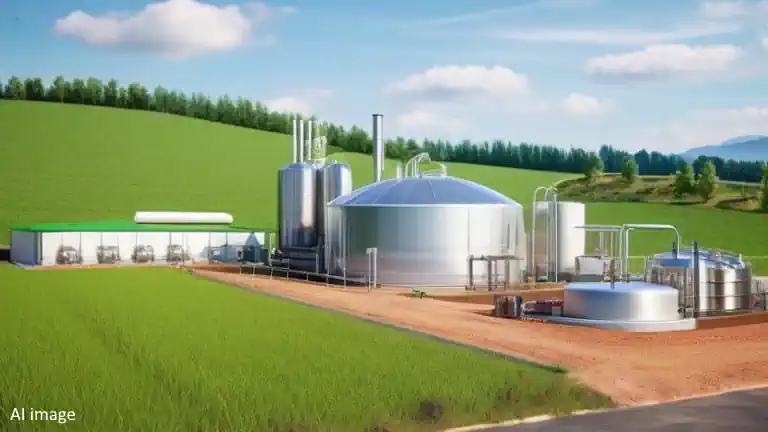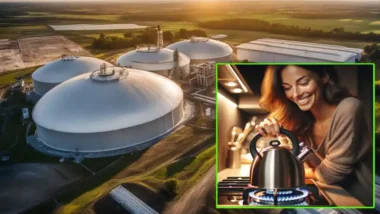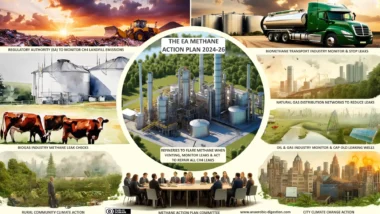Looking for ways to reduce air pollution from cars and trucks can be challenging. One promising solution is biomethane for transport, a green fuel. This article explores how biomethane could change transport for the better, making it cleaner and more sustainable.
Keep reading to find out more!
Biomethane for Transport – Key Takeaways
- Biomethane is a clean renewable fuel that can greatly reduce pollution from transport, aiming for a production target of 35 billion cubic metres in the EU by 2030.
- The European Commission's REPowerEU Action Plan supports energy independence with a focus on biomethane and hydrogen to cut reliance on fossil fuels like those from Russia.
- Technologies such as anaerobic digestion and gasification are key to turning waste into biomethane, which can replace natural gas in various applications including powering vehicles and generating electricity.
- Investment and support are necessary to overcome challenges in expanding biomethane use, requiring €83 billion to meet the EU’s 2030 production goal.
The European Commission's REPowerEU Action Plan
The European Commission's REPowerEU Action Plan aims to diversify gas supplies and increase levels of biomethane and hydrogen, in line with the renewable energy directive.

Diversifying gas supplies
Europe is making big changes to its gas supplies. The plan focuses on getting more LNG imports and pipeline imports that do not come from Russia. This shift aims at cutting Europe's reliance on Russian fossil fuels well before 2030.
By doing this, Europe hopes to make its energy system more secure and less dependent on a single source.
As part of these efforts, I have seen firsthand how diversifying sources can lead to a more resilient energy network across the continent. Europe is putting in place measures that encourage the use of alternative gases like biomethane and hydrogen.
These steps are crucial for moving towards a cleaner, decarbonised future. Now, let's discuss increasing levels of biomethane and hydrogen as key elements in this transition.
Increasing levels of biomethane and hydrogen
The REPowerEU Action Plan has set big goals. It wants more biomethane and hydrogen in our energy mix. This is huge for cutting down on carbon footprints. They're working hard to reach 35 billion cubic meters of biomethane by 2030.
That's a lot! By using things like anaerobic digestion, we can turn waste into power. This isn't just talk; I've seen many plants that convert organic waste into clean fuel.
Hydrogen plays a big part too. Green hydrogen comes from renewable sources, including biomethane making it super clean. With advancements in technology, such as electrolysis—splitting water into oxygen and hydrogen using electricity from renewable sources— we are stepping up our game.
This approach not only supports the circular economy but also pushes Europe towards energy independence, which is critical given today's climate crises and geopolitical tensions.
The Biomethane Action Plan
The Biomethane Action Plan aims to increase biomethane production within the EU to 35 billion cubic metres by 2030. Tools for increasing production include streamlining regulations and incentivising investment in biomethane infrastructure.

Aim to increase biomethane production within the EU to 35 billion cubic meters by 2030
Europe has a big goal. It wants to make 35 billion cubic meters of biomethane by 2030. This plan is bold but necessary for cleaner air and less reliance on other energy sources. Making more biomethane means turning organic waste into valuable fuel.
This process can help reduce greenhouse gas emissions, making our planet healthier.
From my work in the field, I've seen how using modern tools like membrane separation can make biomethane production more efficient. These technologies take biogas from waste treatment plants and turn it into high-quality fuel that cars, heavy goods vehicles, and buses can use instead of diesel or petrol.
With investment and support, Europe can indeed reach its target by 2030, proving that turning waste into energy is not just possible but practical too.
Next, we need to find ways to overcome challenges in bringing this green fuel into wider use across the continent.
Tools for increasing production
Meeting the ambitious goal to increase biomethane production in the EU to 35 billion cubic meters by 2030 requires effective strategies. Here's how we can achieve this target:
- Industrial partnerships stand as a key player for growth. Businesses across Europe can come together, sharing technologies and best practices. This teamwork boosts production rates significantly.
- Offering financial incentives encourages companies and farmers to dive into biomethane production. Government grants, tax benefits, and low-interest loans make projects more appealing.
- Support from rural development funds ensures that communities can build the necessary infrastructure for biomethane projects. This funding helps with everything, from construction costs to training workers.
- Embracing innovative technologies like gasification and anaerobic digestion turns organic waste into valuable biomethane fuel. These methods are efficient and sustainable.
- Streamlining the permitting process makes it easier for new projects to start. Cutting red tape speeds up everything, allowing more plants to begin producing biomethane quickly.
- Educating stakeholders about the benefits of biomethane is crucial for building support among policymakers, businesses, and the public.
Each of these tools plays a vital role in expanding Europe's capacity to produce more clean, renewable energy through biomethane, driving us towards a greener future.
Unlocking these strategies will pave the way for meeting our 2030 targets and beyond, fostering sustainable transportation across Europe and ensuring energy security at a time when it's needed most.
Challenges and Support for Biomethane Deployment
Biomethane deployment faces challenges in permitting and requires substantial investment. The industry needs support for streamlining the permitting process and securing necessary funding.

Facilitating the permitting process
Speeding up the approval process for biomethane projects is key. Our Secretary General, Giulia Cancian, stressed this fact. She pointed out that quicker permits would help get more biomethane into our fuel supplies faster.
My own experience backs this up. I've seen how slow paperwork can delay vital projects.
We need simpler rules and faster decisions to move ahead. By cutting red tape, we can boost clean energy and help the environment sooner. This change will make it easier to build new biomethane plants across Europe, leading to more jobs and cleaner air for everyone.
Investment and support is needed
To reach the goal of increasing biomethane production in the EU to 35 billion cubic meters by 2030, a hefty investment is crucial. Experts estimate this will require about €83 billion.
This figure might sound huge, but think of it as planting seeds for a greener future. From my own work in waste management, I've seen how funding can turn innovative ideas into reality.
More than just money, support from rural development funds will also help. This extra push could make all the difference.
With enough financial backing and encouragement from various sectors, we can overcome many hurdles that currently hinder biomethane's growth. Imagine local farms transforming waste into clean energy or cities powered by gas that once rotted in landfills.
For this vision to come true, every bit counts—every euro invested and every policy crafted towards cleaner energy. Now let's look at how Europe is already on this path with its current biomethane production efforts.
Biomethane Production in Europe
5. Biomethane production in Europe has vast growth potential in various countries and faces challenges leading to stagnation in others. Factors such as demand, infrastructure, and policy frameworks significantly influence the progress of biomethane production.

Growth potential in different countries
France, the Netherlands, Nordic countries, and Spain stand out for their biomethane growth potential. Each of these countries has unique advantages that make them ripe for development in this field.
France already shows a strong commitment to renewable energy projects. This includes an impressive number of plants turning waste into power. The Netherlands benefits from an extensive natural gas network that can easily switch to biomethane.
My experience visiting biogas sites in these areas confirmed the enthusiasm and support local governments have for such initiatives. Nordic countries leverage cold climates to improve the efficiency of biogas production processes, reducing overall costs.
Spain's vast agricultural sector provides ample raw materials for biomethane generation, pointing towards untapped potential ready for investment.
Europe is currently home to over 20,000 biogas and biomethane plants, signalling a robust foundation ready for expansion. With proper support and continued investment, these nations could lead the way in sustainable transportation fuel alternatives throughout Europe and beyond.
Challenges and stagnation in some countries
Some European countries face challenges in developing biomethane due to cancelled subsidies and insufficient infrastructure support. For instance, Germany's biomethane production has stagnated for these reasons.
This hinders the growth potential of biomethane in these regions and requires specific support and investment to overcome these hurdles, boosting the sector's progress.
The UK biogas sector lacks support from the government, nevertheless, good growth occurred during 2023 mostly from new capacity added to existing facilities.
Moving forward to discuss Biomethane Production in Europe…
Benefits and Applications of Biomethane
Biomethane is similar to natural gas and can replace its usage across various sectors, contributing to greenhouse gas reduction and air quality improvement. Its applications span from fuelling CNG buses and heavy-duty vehicles to powering electricity generation plants, offering a cleaner alternative with significant potential for decarbonising transportation and energy production.
Similarity to natural gas
Biomethane shares many characteristics with natural gas, making it possible to be directly integrated into the existing gas grid without requiring extensive modifications. It possesses similar energy properties and can be utilised across a range of applications where natural gas is currently employed.
This similarity enables biomethane to play an essential role in accelerating the transition towards more sustainable transportation solutions and clean energy sources. The cohesive nature between biomethane and natural gas also facilitates a smoother integration process within various infrastructures across Europe.
Moving on to “Replacing all uses of natural gases,”…
Replacing all uses of natural gas
Biomethane, as the only truly green gas, can effectively replace all uses of natural gas in power generation, heating systems, and transportation. With its comparable characteristics to natural gas and sustainability benefits, biomethane offers a feasible pathway for reducing carbon emissions across various sectors.
This transition presents a significant opportunity for environmental researchers, waste management professionals, and government officials to contribute to decarbonisation efforts.
The huge potential for biomethane for transport to replace natural gas aligns with the European Commission's REPowerEU Action Plan and the Biomethane Action Plan's aim to increase production within the EU by 2030.
Biogas Upgrading Technologies
Biogas upgrading technologies employ methods such as membrane separation and biological methanation to efficiently process biogas for use. These technologies play a crucial role in enabling the transformation of biogas into renewable natural gas for widespread application.
Methods and efficiency of biogas upgrading
Biogas upgrading involves various methods to increase efficiency:
- Membrane Separation: Using semi-permeable membranes to separate biogas components, achieving high purity levels.
- Pressure Swing Adsorption: Utilising adsorbents to capture impurities under pressure and subsequently releasing them when the pressure is reduced.
- Amine Scrubbing: Involves using amines to absorb carbon dioxide and hydrogen sulphide, leading to cleaner biogas.
- Water Wash: Employing water scrubbers to remove impurities from biogas through absorption and subsequent removal of contaminants.
- Specific Efficiency Measures: Monitoring and controlling the process parameters such as temperature, pressure, and flow rates to optimise production and energy consumption.
These techniques play a vital role in enhancing the overall efficiency of biogas upgrading, contributing significantly to sustainable energy practices.
Membrane separation and biological methanation
Moving from methods of biogas upgrading to the efficiency of membrane separation and biological methanation. Membrane separation stands as a cost-effective method, requiring minimal energy and no chemicals or water.
It's the most widely used approach, offering high efficiency at low costs. On the other hand, biological methanation has been an integral part of feeding biomethane into natural gas grids since 2016.
These technologies are crucial in enhancing biomethane production while aligning with sustainable goals. Their impact not only complements waste management strategies but also supports the renewable energy sector by contributing to increased levels of biomethane and hydrogen within the EU.
Reference Projects
1. Sweden's biomethane plant at Lidköping successfully produces and supplies renewable fuels to the transportation sector.
2. Germany's innovative biogas upgrading facility in North Rhine-Westphalia supports sustainable energy production.
Examples of biomethane plants and their capabilities
Methaisne Energies Vertes in Gauchy, France, processes 440 Nm³/h biomethane.
Marlenheim biomethane plant in Marlenheim creates 210 Nm³ of biomethane per hour.
- Methaisne Energies Vertes has advanced gas treatment technology.
- The Marlenheim plant is dedicated to producing sustainable energy.
These plants demonstrate the potential for widespread use and application of biomethane in sustainable energy solutions.
Future of Biomethane Industry
The future of the biomethane industry holds promise for energy independence and reducing greenhouse gas emissions. Read on to explore the potential challenges and opportunities in this evolving sector, and in particular the biomethane for transport sector.
Energy independence and potential challenges
Achieving energy independence is critical for environmental sustainability. The use of biomethane plays a pivotal role in reducing reliance on politically unstable regimes and enhancing local energy security.
However, challenges such as initial investment costs, regulatory barriers, and technological advancements must be addressed to fully realise the potential of biomethane for transport/ in sustainable transportation.
Waste management professionals must continue to focus on efficient collection and pre-treatment of organic waste, especially food waste, and whenever possible use biogas upgrading technologies that can enhance the production of high-quality biomethane.
These actions will foster greater energy independence while mitigating potential challenges within the industry.
The future growth and viability of sustainable transportation during the transition to hydrogen fuels depends greatly on addressing these challenges through collaborative efforts between governments, the public, waste management professionals, researchers, and industry stakeholders.
Use in developing and emerging countries
Developing and emerging countries will increasingly come to rely on biomethane for transport to bolster their energy independence. We can only stress that biomethane for transport offers a sustainable alternative to fossil fuels, reducing greenhouse gas emissions and providing cleaner energy options.
With many companies building mini-biogas plants, across many developing and emerging countries, these nations have the potential to embrace biomethane production, lessening their dependence on traditional fuel sources. The adoption of biogas power and renewable electricity in these regions presents opportunities for economic growth and environmental sustainability.
Biomethane for Transport: Our Conclusion
Biomethane is a green and sustainable alternative to fossil fuels, with the potential to transform transportation.
The European Commission's REPowerEU Action Plan provides a comprehensive roadmap for energy independence from Russian fossil fuels. It emphasises diversifying gas supplies through higher LNG imports and increased levels of biomethane and hydrogen.
The Biomethane Action Plan aims to significantly increase biomethane production in the EU by 2030, offering tools such as industrial partnerships and financial incentives.
To accelerate the deployment biomethane for transport, it's crucial to facilitate the permitting process. The support from organisations like the European Biogas Association underlines the importance of this ambitious plan.
Europe already has over 20,000 biogas and biomethane plants, demonstrating a strong foundation for further growth. Countries like France, the Netherlands, Nordic countries, and Spain especially show significant potential for development in this sector.
Biomethane presents an opportunity to replace all uses of natural gas – power generation, heating systems, and transportation. This can lead us towards cleaner air quality while reducing our reliance on fossil fuels.
Biomethane for Transport FAQs
1. What exactly is biomethane, and why is it important for sustainable transport?
Biomethane, a renewable energy source derived from organic materials like wastewater treatment by-products and energy crops, plays a critical role in decarbonising our transport sector.
By replacing fossil fuels with cleaner alternatives such as biomethane in vehicles, including cars and heavy fuel oil-powered ships – we significantly reduce CO2 and methane emissions, contributing to cleaner air and combating the climate crisis.
2. How does biomethane compare to electric vehicles (EVs) in reducing emissions?
While electric vehicles, especially battery electric vehicles (BEVs) and plug-in hybrid electric vehicles (PHEVs), are pivotal in lowering urban CO2 emissions through the electrification of the transport system, biomethane offers a complementary solution. It reduces greenhouse gas (GHG) emissions not just tank-to-wheels but well-to-wheels when considering its entire life cycle assessment, capturing fugitive methane emissions during production that would otherwise contribute to global warming.
3. Can biomethane help achieve the European Green Deal's goals?
Absolutely! The European Green Deal sets ambitious targets for reducing GHG emissions across all sectors of the economy, including transportation. Biomethane’s low carbon intensity, alongside other low-carbon technologies like solar power generation or wind energy, supports these goals by providing cleaner electricity options for plug-in hybrids, hydrogen fuel production for cleaner vehicles, and even direct use in natural gas engines.
4. What are some challenges facing the adoption of biomethane as an alternative fuel?
Despite its benefits, several hurdles exist:
- infrastructure development for distribution needs ramping up; competition from fossil gas on price points remains tough;
- Plus, there's ongoing work required on public perception around nitrogen oxides (NOx) emissions from combustion processes, which need clear communication regarding their management.
5. Are there any incentives or support systems available to encourage using biomethane in transport?
Indeed! Various mechanisms have been implemented across EU-27 countries, ranging from:
- subsidies for clean vehicle purchases, including those powered by biogas;
- tax breaks on lower-emission fuels; credits within emission trading systems encouraging industries towards cleaner power-generation methods like Combined Heat power (CHP);
all designed to bolster competitiveness against traditional fossil oil-based solutions while promoting hydrogen production via electrolysis powered by renewable sources.
6. Looking ahead: what future developments could further enhance biomass's role in sustainable mobility?
Innovation continues at pace with:
- digestate processing purity improvements, enhancing yields from cleaner organic pulp;
- advancements in engine technology, allowing better performance with lower particulate matter output;
- more efficient hydrogen production methods, promising seamless integration into existing transmission networks;
- ever-improving life cycle assessments, ensuring a continuous reduction of overall environmental impact.
As these areas progress, expect wider acceptance, and greater demand response capabilities, leading towards a truly decarbonised future where synthetic fuels play an integral part alongside electrification efforts.







